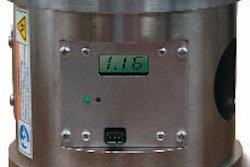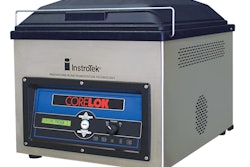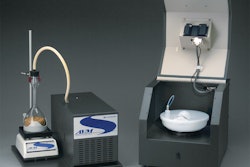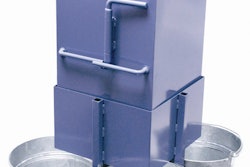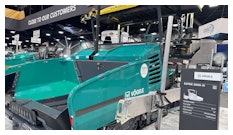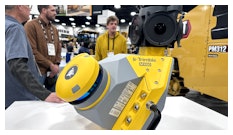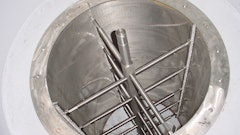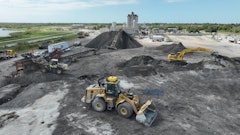Determining the bulk specific gravity of fine aggregate is important when designing hot mix asphalt. The bulk specific gravity is used in calculating the voids in the mineral aggregate of an HMA mixture. The current method of determining dry bulk specific gravity (Gsb) — AASHTO T 84 — uses a cone and tamp to determine the saturated surface-dry (SSD) condition of fine aggregate. This method does not work well when determining the SSD condition of angular or rough fine aggregates because they do not readily slump. Therefore, a more accurate and repeatable method of determining Gsb is needed to provide lower variability between operators and to address problems with angular materials. In order to solve this problem, a method that is more automated and less user dependent is needed to determine both Gsb and absorption of fine aggregates.
During the 1970s, the Arizona Department of Transportation tried to develop a prototype for determining SSD using a rotating vertical tube. Warm air was blown through the tube while it rotated. Using the plots of the inlet and outlet temperature and the basic principles of thermodynamics, they determined the SSD region of these plots. The prototype produced encouraging results, however, it had a high variability.
The National Center for Asphalt Technology continued working on Arizona DOT's ideas. Instead of blowing warm air vertically over the sample, NCAT tried blowing the warm air longitudinally in a steel drum while it was rotating on its side. NCAT discovered that the SSD point could be determined more repeatable by monitoring the outgoing relative humidity. There were several problems with this method, including: inconsistent drying, loss of fines, clogging of screens, aggregate sticking to the drum and the prototype was not automated.
Testing of two automated measuring devices — the InstroTek Corelok prototype and the Barnstead/Thermolyne SSDetect eventually produced quantifiable results that were used to plot consistent and repeatable measurements. Both InstroTek and Thermolyne tried the "dry to wet" approach of obtaining Gsb and absorption. InstroTek used a calibrated pycnometer and vacuum pressure and Thermolyne used an infrared signal to determine SSD combined with a vacuum and agitation system to determine apparent specific gravity (Gsa).
InstroTek devised a method using a combination of a calibrated pycnometer and vacuum-sealing device to determine Gsb and absorption. The pycnometer (volumeter) is used to determine the bulk volume of the sample and the vacuum-sealing device is used in determining the apparent specific gravity. The Gsb is the overall volume of an aggregate particle including the volume of the pores that are filled with water. The InstroTek approach requires that sample be placed into a calibrated pycnometer. The volume of the pycnometer is calibrated by filling it completely with water (before each set of 10 samples). To test a sample, the container is halfway filled with water and a 500-gram dry sample is added. The sample is stirred to remove entrapped air. Additional water is added and a lid is then placed on the pycnometer. The remaining air space is then filled with water. This is used to determine the volume of the aggregate by the displacement of the water. This whole process is done within two minutes to reduce the amount of water absorbed into the pores of the aggregate, thus producing the bulk volume of the fine aggregate.
The equipment of the Thermolyne procedure for determining fine aggregate Gsb and absorption consists of two parts, the AVM unit and the SSDetect device. The AVM unit is an automated device for removing entrapped air from a volumetric flask. The unit includes and automated vacuum source and orbital mixer. A 500 ml volumetric flask is partially filled with water. A 500-gram sample of fine aggregate is added to the flask and the flask filled with water to the calibration mark. The flask is then loaded into the AVM. The AVM removes the entrapped air through the application of the orbital mixing action and partial vacuum over approximately a 16-minute period. After the flask is refilled to the calibration, its weight is determined. The AVM sample is used to determine Gsa and the film coefficient. The film coefficient is a calibration factor for the infrared reflectance measurements made with the SSDetect.
The SSDetect device consists of an orbital mixer, calibrated water injection pump, infrared source, infrared detector and mixing bowl. The SSDetect also includes an integral processor, accessible using a touch screen. The mixing bowl has a lid with two sapphire lenses. The lid prevents evaporation or loss of sample during mixing and the lenses allow transmission of the infrared light. A 500-gram dry fine aggregate sample is placed in the SSDetect mixing bowl. The film coefficient determined using the AVM is entered into the SSDetect. Once the unit is started, the calibrated pump begins injecting water into the mixing bowl. The orbital mixer ensures even distribution among the fine aggregate sample. The water is drawn into the sample by capillary action. The infrared light source and detector are used to determine when the sample has reached the SSD state. Infrared light is absorbed by water. The infrared detectors are used to determine when the infrared light is being absorbed by water, indicating that the sample has reached the SSD state. An audible alarm then indicates that the sample should be weighed. This allows calculation of the samples water absorption. The sample water absorption and Gsa can be used to calculate Gsb. Testing in the SSDetect takes approximately one hour and fifteen minutes.
As a result of the test, new methods of determining fine aggregate specific gravity have been developed. The InstroTek Corelok and the Thermolyne SSDetect were evaluated in a round robin study.
Both methods offer significant time savings over AASHTO T 84. Neither method requires the 16-hour soak period included in AASHTO T 84. This means that HMA belt sweep samples could be taken to verify gravities during construction for volumetric calculations in a timely manner.
Both methods generally produce Gsb results that are similar to AASHTO T 84. Where statistical differences occurred for Gsb between the new methods and AASHTO T 84, the differences were smaller for the SSDetect method. The SSDetect offers improved precision as compared to AASHTO T 84.
Information provided by the National Center for Asphalt Technology at the 83rd Annual Meeting of the Transportation Research Board.
Gilson SP-55 Quartermaster
Designed to handle large samples required in Superpave specifications, Gilson's SP-55 Quartermaster divides hot mix asphalt samples for quality control analysis.
- Field samples of 120 pounds are quickly reduced
- Large hopper reduces handling of hot material between procurement of initial field sample and production of lab samples
- Rugged steel construction
Barnstead Thermolyne SSDetect System
Barnstead offers the Thermolyne SSDetect two-part system for determining the bulk specific gravity and absorption of fine aggregate.
- Directly measures the saturated surface dry (SSD) condition through an infrared detection system tuned to water
TransTech PQI301
The TransTech PQI301 is a non-nuclear pavement quality indicator designed to take fast, accurate measurement of hot mix asphalt density.
- Takes accurate density readings in three seconds
- Covered by AASHTO and ASTM test methods
- For perpetual pavement mixes
- Available in various languages
Interlaken Test System
Interlaken Technology offers a compact, servo-hydraulic test system that can perform a range of static and dynamic tests for both soil and asphalt.
- Fulfills the requirements of ASTM, AASHTO and SHRP specifications
- Several pre-programmed software applications are available, including fully integrated software for control, data acquisition and real time monitoring
- Accessories and fixtures include environmental chambers, indirect tensile fixtures, magnetic-mounted extensometers and various load cells and triaxial cells
Humboldt Roughometer II
The Roughometer II can be used to assess paved and unpaved roads by providing objective and repeatable data regarding the actual roughness level of the surface.
- Easily mounts to almost any vehicle
- Gathers data and transfers it to a PC
- Displays information in International Roughness numbers in both graphic charts and tables
- Data can be transported to spreadsheet and database programs
Despatch RTF Oven
The Rolling Thin Film (RTF) asphalt oven from Despatch is designed for testing the effects of heat and air on moving films of asphalt in accordance with ASTM and AASHTO designations.
- Maximum temperature of 400 degrees F
- Digital temperature controls
InstroTek SmartPanel
The SmartPanel from InstroTek is a replacement part for Troxler moisture-density gauges.
- Specifically made for models 3401 and 3411B
- Upgrades the software and the user interface and includes features such as RS232 communication, backlight for night use, self-test features and more
Pine RAM Device
Pine Instrument Co.'s Rapid Angle Measurement (RAM) device measures their internal angle on Superpave gyratory compactors without hot mix asphalt in under 30 minutes.
- Uses Invelop Load Simulator (ILS) method to imitate the forces applied to the gyratory compactor frame from within the mold
- Allows for a fast, accurate measurement that is reproducible
Malvern Control and Analysis Software for Rheometers
Malvern Instruments has launched a new software version for its range of Malvern Bohlin rheometers: Version 6.40.
- Incorporates many new features, including more flexible data analysis setup and automation and a completely new test type
- New analysis routines have been built into the software, including a new template wizard, improved model fitting capabilities, Time Temperature Superposition (TTS) analysis, and new data manipulation routines
- Extended language support with English, French, German and Spanish language versions available as standard, and the capacity for reconfiguration to support most major European languages
Troxler Enhanced RoadReader Plus Model 3451
Troxler Electronic Laboratories has added the Enhanced RoadReader Plus Model 3451 to its line of nuclear moisture density gauges.
- Measures moisture and density of soils, aggregate, asphalt and concrete
- On-board Global Positioning System (GPS) and a wireless Personal Digital Assistant (PDA) user interface
- Density readings can be measured from 2 to 12 inches using the direct transmission method, or 1 to 4 inches with the backscatter method
- Moisture readings can be read up to 11 inches from the surface of the test material
Engineering Developments Co. offers the gyratory testing machine (GTM), a combination compaction and simple-shear testing machine for use with cylindrical specimens of soils and base course materials as well as asphalt mixes.
- Designed so plastic deformation or rutting can be simulated and predicted independently of voids criteria
- Determines optimum binder content for a required wheel load service
- Provides independent verification of SHRP superpave and other mix design results
Slip Asphalt Depth Gauge
With the asphalt depth gauge from Slip Industries, there's no need to step onto hot asphalt to test asphalt depth or curb height.
- Lubricated gauge will not pull on asphalt or leave large holes
- Lube oil will not contaminant asphalt
- Probe cleaned each time its retracted back into the tool
Geneq Micro-Deval Apparatus
Geneq's Micro-Deval Apparatus evaluates the abrasion in presence of water for coarse and fine aggregates.
- Tests the resistance of fine and coarse aggregates to degradation by abrasion
- Available models include the one, two or three tier
- Standard with jars, balls, timer and magnet
- Available with electronic controller




